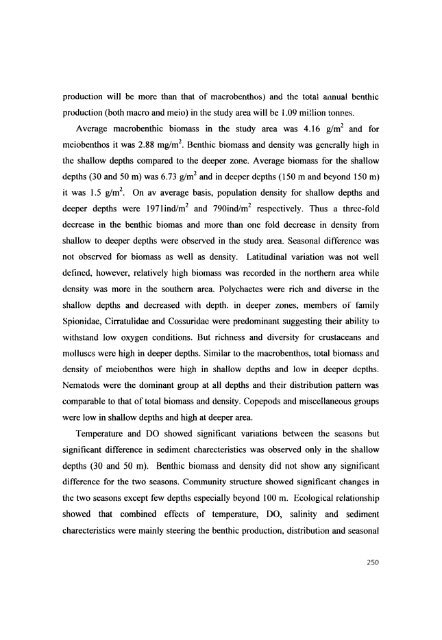L - Cochin University of Science and Technology
L - Cochin University of Science and Technology
L - Cochin University of Science and Technology
Create successful ePaper yourself
Turn your PDF publications into a flip-book with our unique Google optimized e-Paper software.
production will be more than that <strong>of</strong> macrobenthos) <strong>and</strong> the total annual benthic<br />
production (both macro <strong>and</strong> meio) in the study area will be 1.09 million tonnes.<br />
Average macrobenthic biomass in the study area was 4.16 g/m 2 <strong>and</strong> for<br />
meiobenthos it was 2.88 mg/m 2 . Benthic biomass <strong>and</strong> density was generally high in<br />
the shallow depths compared to the deeper zone. Average biomass for the shallow<br />
depths (30 <strong>and</strong> 50 m) was 6.73 g/m 2 <strong>and</strong> in deeper depths (150 m <strong>and</strong> beyond 150 m)<br />
it was 1.5 g/m 2 . On av average basis, population density for shallow depths <strong>and</strong><br />
deeper depths were 1971 ind/m2 <strong>and</strong> 790ind/m 2 respectively. Thus a three-fold<br />
decrease in the benthic biomas <strong>and</strong> more than one fold decrease in density from<br />
shallow to deeper depths were observed in the study area. Seasonal difference was<br />
not observed for biomass as well as density. Latitudinal variation was not well<br />
defined, however, relatively high biomass was recorded in the northern area while<br />
density was more in the southern area. Polychaetes were rich <strong>and</strong> diverse in the<br />
shallow depths <strong>and</strong> decreased with depth. in deeper zones, members <strong>of</strong> family<br />
Spionidae, Cirratulidae <strong>and</strong> Cossuridae were predominant suggesting their ability to<br />
withst<strong>and</strong> low oxygen conditions. But richness <strong>and</strong> diversity for crustaceans <strong>and</strong><br />
molluscs were high in deeper depths. Similar to the macrobenthos, total biomass <strong>and</strong><br />
density <strong>of</strong> meiobenthos were high in shallow depths <strong>and</strong> low in deeper depths.<br />
Nematods were the dominant group at all depths <strong>and</strong> their distribution pattern was<br />
comparable to that <strong>of</strong> total biomass <strong>and</strong> density. Copepods <strong>and</strong> miscellaneous groups<br />
were low in shallow depths <strong>and</strong> high at deeper area.<br />
Temperature <strong>and</strong> DO showed significant variations between the seasons but<br />
significant difference in sediment charecteristics was observed only in the shallow<br />
depths (30 <strong>and</strong> 50 m). Benthic biomass <strong>and</strong> density did not show any significant<br />
difference for the two seasons. Community structure showed significant changes in<br />
the two seasons except few depths especially beyond 100 m. Ecological relationship<br />
showed that combined effects <strong>of</strong> temperature, DO, salinity <strong>and</strong> sediment<br />
charecteristics were mainly steering the benthic production, distribution <strong>and</strong> seasonal<br />
250

















